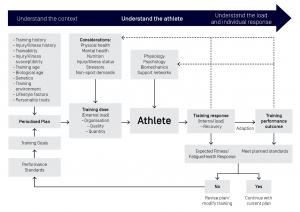Injury Prevention
Injury Prevention – Load Management
By Aaron Woolley, Physiotherapist
The next part of the Robina Physio blog series continues from my previous post about goal setting and injury prevention. Once your goals are set the next part of the puzzle is trying to achieve them without breaking too many times. A well thought out and structured plan won’t stop every injury but it can certainly help prevent injury occurrence and hopefully severity.
Defining Training Load
Before delving into how we go about managing load we need to define it. Load is a term used to describe the training related stress that is placed on the body. Other terms you may hear is “acute load” which is what you did in the last 7 days and “chronic load” which is what you did in the 4 weeks. Proper planning needs to consider more than just which body structures are being stressed for each specific sport because the nature of training load on the human body is highly multifactorial. Training load places physical, psychological, physiological, cognitive, emotional and technical stress on the human body.
From an injury prevention point of view, stressors on connective tissues such as muscle, tendon, ligament and bones are what we predominantly focus on managing. This is even more important when returning from injury because people that have had a recent injury have a noticeably increased risk of injury the same or a different body part again.
Managing Training Load
I truly believe the most important thing to consider here is the individual/athlete. A deep understanding of the person you’re dealing with holds the utmost importance. This includes their physiology (age, sex, medical history/injury history), their training history, mental and nutritional health and not to be understated their non-sports demands (family, work, study).

https://www.ais.gov.au/position_statements/content/training-load-in-relation-to-loading-and-unloading-phases-of-training
From here we can follow a few simple principles to help prevent injury. Keep in mind this is a very simplistic overview of what research tells us.
- Try to keep your load consistent. This links back to acute vs chronic load. Sharp increases or decreases of load will put you in the danger zone for an injury. Aim for weekly increases that do not exceed 30% and decreases that are within 20%. The data has shown that increases above 50% increase your injury risk by up to 8 times.
- Keep it simple. Many of the new fitness/training trends prioritise excitement and flashiness over results. Plus, they also tend to have high injury rates. Sometimes sticking to a tried and tested plan is the best option, especially when you’re just starting out.
- Listen to your body. A simple idea but often neglected. This mainly relates to giving your body enough recovery between sessions. If you’re feeling flat and/or sore maybe consider dropping the intensity or volume for that session. If you’re mentally spent maybe you need a well-timed rest day or some active feel good type of activity.
- Don’t neglect your body. To help prevent injury it’s a good idea to add in some extra recovery aids. You could consider some stretching, foam roller and recovery baths. At Robina Physio on the Gold Coast we can also help with some preventative treatments including massage and dry needling. Got a niggle? Then BOOK NOW before it gets too bad.
- Consider some technique correction and/or cross training. Technical correction help improves your bodies efficiency leading to improved connective tissue loading. Cross training is a simple way to keep you moving whilst minimising overload to the specific body parts you train most.
I hope these posts have been helpful and informative. If you need some assistance managing an injury or if you need some expert advice developing a training load plan and prevent injury Contact Us on (07) 5578 7233 or BOOK ONLINE. The Physiotherapists at Robina Physio on the Gold Coast would love to help.
References
Blanch P, Gabbett TJ. (2016). Has the athlete trained enough to return to play safely? The acute:chronic workload ratio permits clinicians to quantify a player’s risk of subsequent injury. Br J Sports Med; 50: 471–475.



